Comprehensive Report: Opioids Use, Abuse, and Overdose in Australia
VerifiedAdded on 2020/03/16
|6
|1594
|410
Report
AI Summary
This report provides an in-depth analysis of the escalating opioid use in Australia, highlighting it as a significant public health concern. It examines the alarming rise in prescription drug abuse and its impact on the Australian population, citing that more Australians are dying from prescription opioids than from illegal heroin. The report explores the causes of increased opioid use, including longer cancer survival periods, an aging population with chronic pain, changing expectations of pain relief, increased availability of opioids, and aggressive marketing campaigns by pharmaceutical companies. It also investigates the effects of opioid use, such as addiction, breathing problems, sexual dysfunction, and increased risk of death. The report presents statistical data from various sources, including the National Drug Strategy Household Survey (NDSHS) and ABS figures, to illustrate the trends and consequences of opioid use. The report concludes by emphasizing the need for evidence-based guidelines, real-time monitoring systems, and well-laid strategies to address the opioid crisis in Australia.
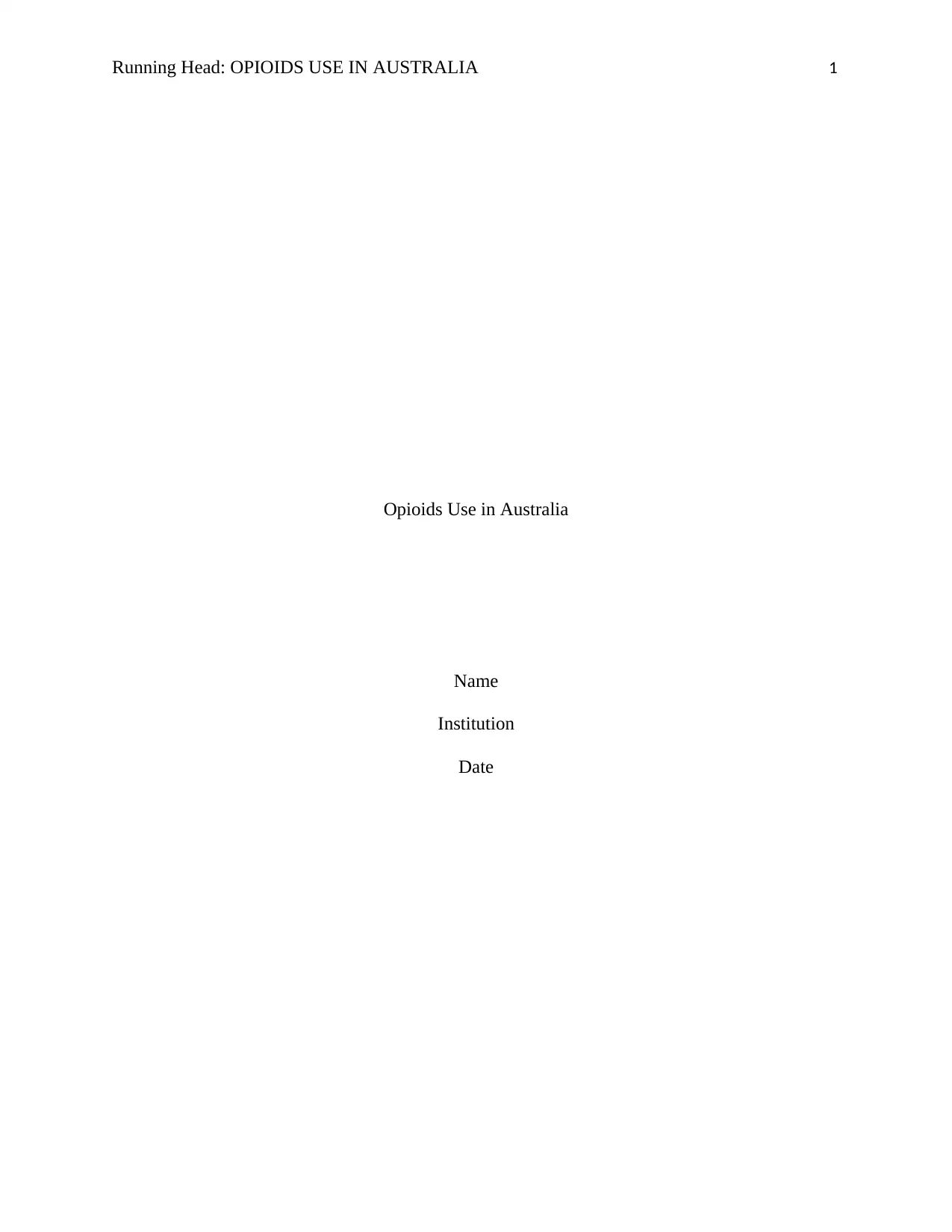
Running Head: OPIOIDS USE IN AUSTRALIA 1
Opioids Use in Australia
Name
Institution
Date
Opioids Use in Australia
Name
Institution
Date
Paraphrase This Document
Need a fresh take? Get an instant paraphrase of this document with our AI Paraphraser
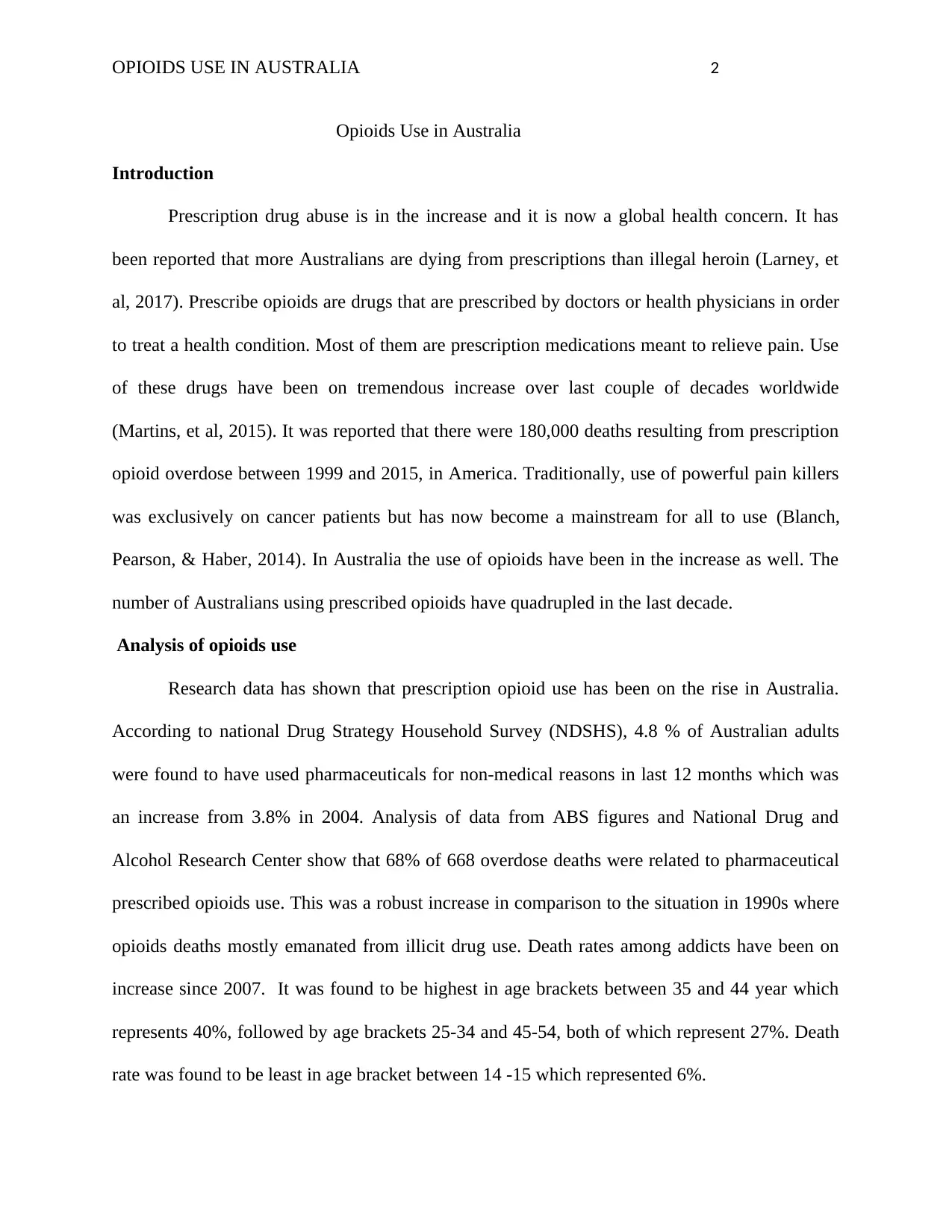
OPIOIDS USE IN AUSTRALIA 2
Opioids Use in Australia
Introduction
Prescription drug abuse is in the increase and it is now a global health concern. It has
been reported that more Australians are dying from prescriptions than illegal heroin (Larney, et
al, 2017). Prescribe opioids are drugs that are prescribed by doctors or health physicians in order
to treat a health condition. Most of them are prescription medications meant to relieve pain. Use
of these drugs have been on tremendous increase over last couple of decades worldwide
(Martins, et al, 2015). It was reported that there were 180,000 deaths resulting from prescription
opioid overdose between 1999 and 2015, in America. Traditionally, use of powerful pain killers
was exclusively on cancer patients but has now become a mainstream for all to use (Blanch,
Pearson, & Haber, 2014). In Australia the use of opioids have been in the increase as well. The
number of Australians using prescribed opioids have quadrupled in the last decade.
Analysis of opioids use
Research data has shown that prescription opioid use has been on the rise in Australia.
According to national Drug Strategy Household Survey (NDSHS), 4.8 % of Australian adults
were found to have used pharmaceuticals for non-medical reasons in last 12 months which was
an increase from 3.8% in 2004. Analysis of data from ABS figures and National Drug and
Alcohol Research Center show that 68% of 668 overdose deaths were related to pharmaceutical
prescribed opioids use. This was a robust increase in comparison to the situation in 1990s where
opioids deaths mostly emanated from illicit drug use. Death rates among addicts have been on
increase since 2007. It was found to be highest in age brackets between 35 and 44 year which
represents 40%, followed by age brackets 25-34 and 45-54, both of which represent 27%. Death
rate was found to be least in age bracket between 14 -15 which represented 6%.
Opioids Use in Australia
Introduction
Prescription drug abuse is in the increase and it is now a global health concern. It has
been reported that more Australians are dying from prescriptions than illegal heroin (Larney, et
al, 2017). Prescribe opioids are drugs that are prescribed by doctors or health physicians in order
to treat a health condition. Most of them are prescription medications meant to relieve pain. Use
of these drugs have been on tremendous increase over last couple of decades worldwide
(Martins, et al, 2015). It was reported that there were 180,000 deaths resulting from prescription
opioid overdose between 1999 and 2015, in America. Traditionally, use of powerful pain killers
was exclusively on cancer patients but has now become a mainstream for all to use (Blanch,
Pearson, & Haber, 2014). In Australia the use of opioids have been in the increase as well. The
number of Australians using prescribed opioids have quadrupled in the last decade.
Analysis of opioids use
Research data has shown that prescription opioid use has been on the rise in Australia.
According to national Drug Strategy Household Survey (NDSHS), 4.8 % of Australian adults
were found to have used pharmaceuticals for non-medical reasons in last 12 months which was
an increase from 3.8% in 2004. Analysis of data from ABS figures and National Drug and
Alcohol Research Center show that 68% of 668 overdose deaths were related to pharmaceutical
prescribed opioids use. This was a robust increase in comparison to the situation in 1990s where
opioids deaths mostly emanated from illicit drug use. Death rates among addicts have been on
increase since 2007. It was found to be highest in age brackets between 35 and 44 year which
represents 40%, followed by age brackets 25-34 and 45-54, both of which represent 27%. Death
rate was found to be least in age bracket between 14 -15 which represented 6%.
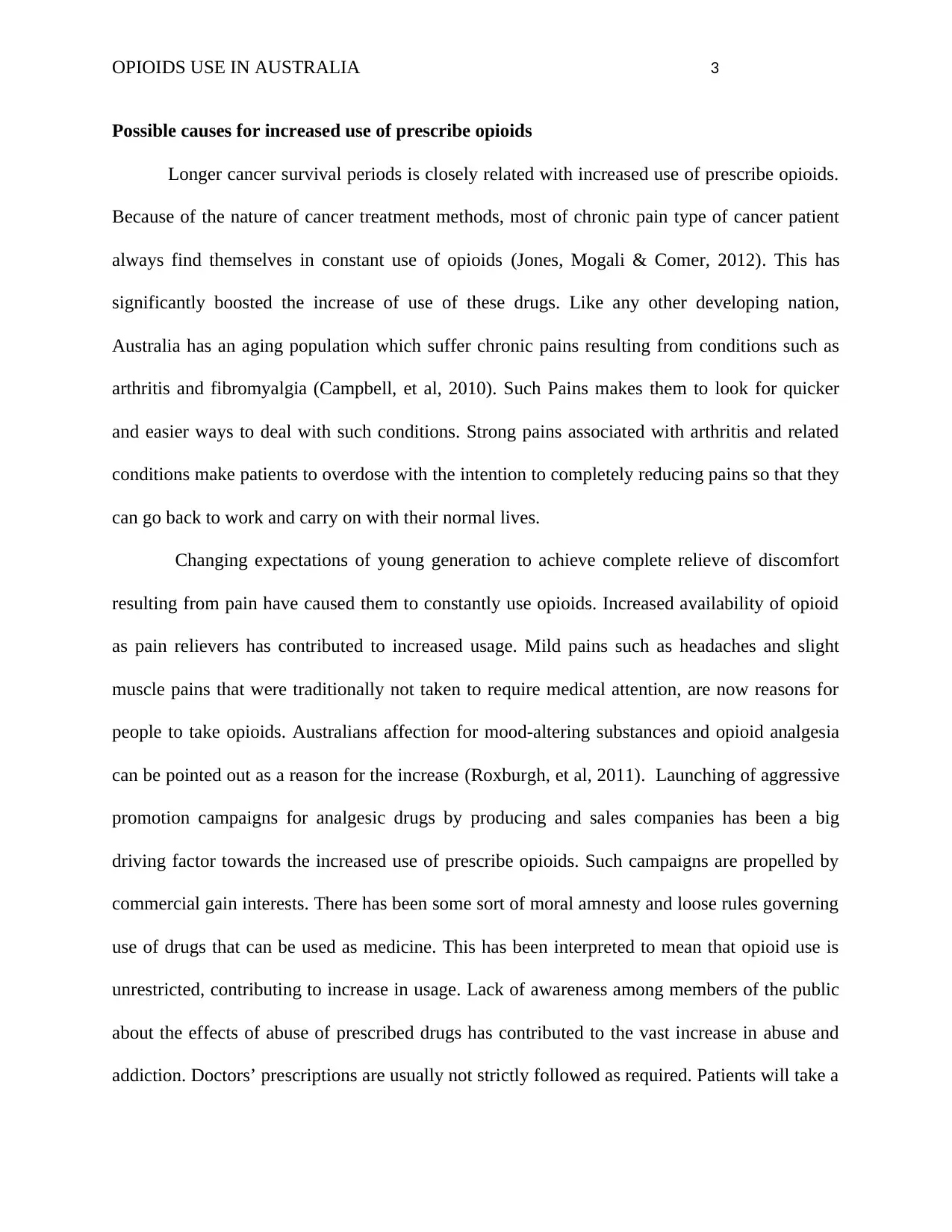
OPIOIDS USE IN AUSTRALIA 3
Possible causes for increased use of prescribe opioids
Longer cancer survival periods is closely related with increased use of prescribe opioids.
Because of the nature of cancer treatment methods, most of chronic pain type of cancer patient
always find themselves in constant use of opioids (Jones, Mogali & Comer, 2012). This has
significantly boosted the increase of use of these drugs. Like any other developing nation,
Australia has an aging population which suffer chronic pains resulting from conditions such as
arthritis and fibromyalgia (Campbell, et al, 2010). Such Pains makes them to look for quicker
and easier ways to deal with such conditions. Strong pains associated with arthritis and related
conditions make patients to overdose with the intention to completely reducing pains so that they
can go back to work and carry on with their normal lives.
Changing expectations of young generation to achieve complete relieve of discomfort
resulting from pain have caused them to constantly use opioids. Increased availability of opioid
as pain relievers has contributed to increased usage. Mild pains such as headaches and slight
muscle pains that were traditionally not taken to require medical attention, are now reasons for
people to take opioids. Australians affection for mood-altering substances and opioid analgesia
can be pointed out as a reason for the increase (Roxburgh, et al, 2011). Launching of aggressive
promotion campaigns for analgesic drugs by producing and sales companies has been a big
driving factor towards the increased use of prescribe opioids. Such campaigns are propelled by
commercial gain interests. There has been some sort of moral amnesty and loose rules governing
use of drugs that can be used as medicine. This has been interpreted to mean that opioid use is
unrestricted, contributing to increase in usage. Lack of awareness among members of the public
about the effects of abuse of prescribed drugs has contributed to the vast increase in abuse and
addiction. Doctors’ prescriptions are usually not strictly followed as required. Patients will take a
Possible causes for increased use of prescribe opioids
Longer cancer survival periods is closely related with increased use of prescribe opioids.
Because of the nature of cancer treatment methods, most of chronic pain type of cancer patient
always find themselves in constant use of opioids (Jones, Mogali & Comer, 2012). This has
significantly boosted the increase of use of these drugs. Like any other developing nation,
Australia has an aging population which suffer chronic pains resulting from conditions such as
arthritis and fibromyalgia (Campbell, et al, 2010). Such Pains makes them to look for quicker
and easier ways to deal with such conditions. Strong pains associated with arthritis and related
conditions make patients to overdose with the intention to completely reducing pains so that they
can go back to work and carry on with their normal lives.
Changing expectations of young generation to achieve complete relieve of discomfort
resulting from pain have caused them to constantly use opioids. Increased availability of opioid
as pain relievers has contributed to increased usage. Mild pains such as headaches and slight
muscle pains that were traditionally not taken to require medical attention, are now reasons for
people to take opioids. Australians affection for mood-altering substances and opioid analgesia
can be pointed out as a reason for the increase (Roxburgh, et al, 2011). Launching of aggressive
promotion campaigns for analgesic drugs by producing and sales companies has been a big
driving factor towards the increased use of prescribe opioids. Such campaigns are propelled by
commercial gain interests. There has been some sort of moral amnesty and loose rules governing
use of drugs that can be used as medicine. This has been interpreted to mean that opioid use is
unrestricted, contributing to increase in usage. Lack of awareness among members of the public
about the effects of abuse of prescribed drugs has contributed to the vast increase in abuse and
addiction. Doctors’ prescriptions are usually not strictly followed as required. Patients will take a
⊘ This is a preview!⊘
Do you want full access?
Subscribe today to unlock all pages.

Trusted by 1+ million students worldwide
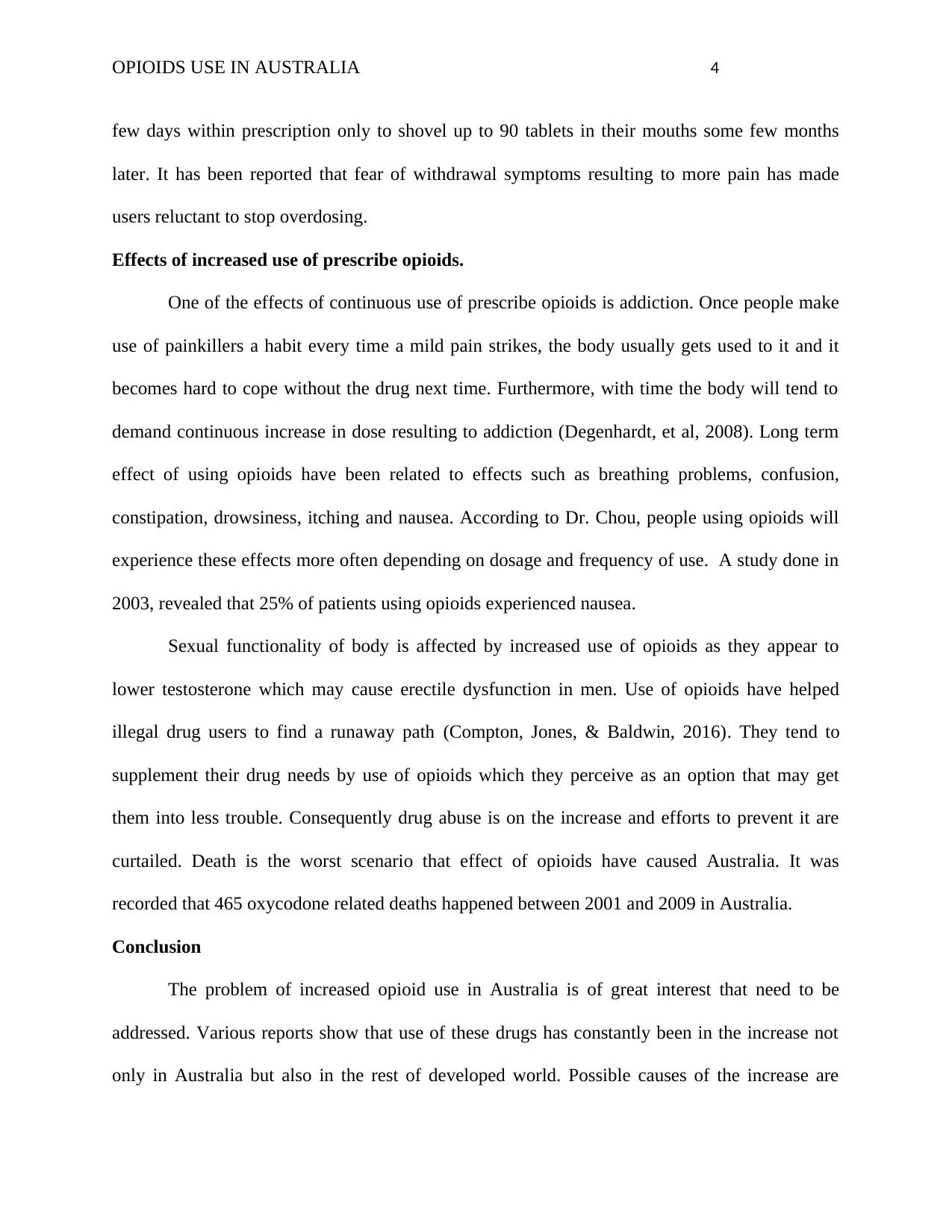
OPIOIDS USE IN AUSTRALIA 4
few days within prescription only to shovel up to 90 tablets in their mouths some few months
later. It has been reported that fear of withdrawal symptoms resulting to more pain has made
users reluctant to stop overdosing.
Effects of increased use of prescribe opioids.
One of the effects of continuous use of prescribe opioids is addiction. Once people make
use of painkillers a habit every time a mild pain strikes, the body usually gets used to it and it
becomes hard to cope without the drug next time. Furthermore, with time the body will tend to
demand continuous increase in dose resulting to addiction (Degenhardt, et al, 2008). Long term
effect of using opioids have been related to effects such as breathing problems, confusion,
constipation, drowsiness, itching and nausea. According to Dr. Chou, people using opioids will
experience these effects more often depending on dosage and frequency of use. A study done in
2003, revealed that 25% of patients using opioids experienced nausea.
Sexual functionality of body is affected by increased use of opioids as they appear to
lower testosterone which may cause erectile dysfunction in men. Use of opioids have helped
illegal drug users to find a runaway path (Compton, Jones, & Baldwin, 2016). They tend to
supplement their drug needs by use of opioids which they perceive as an option that may get
them into less trouble. Consequently drug abuse is on the increase and efforts to prevent it are
curtailed. Death is the worst scenario that effect of opioids have caused Australia. It was
recorded that 465 oxycodone related deaths happened between 2001 and 2009 in Australia.
Conclusion
The problem of increased opioid use in Australia is of great interest that need to be
addressed. Various reports show that use of these drugs has constantly been in the increase not
only in Australia but also in the rest of developed world. Possible causes of the increase are
few days within prescription only to shovel up to 90 tablets in their mouths some few months
later. It has been reported that fear of withdrawal symptoms resulting to more pain has made
users reluctant to stop overdosing.
Effects of increased use of prescribe opioids.
One of the effects of continuous use of prescribe opioids is addiction. Once people make
use of painkillers a habit every time a mild pain strikes, the body usually gets used to it and it
becomes hard to cope without the drug next time. Furthermore, with time the body will tend to
demand continuous increase in dose resulting to addiction (Degenhardt, et al, 2008). Long term
effect of using opioids have been related to effects such as breathing problems, confusion,
constipation, drowsiness, itching and nausea. According to Dr. Chou, people using opioids will
experience these effects more often depending on dosage and frequency of use. A study done in
2003, revealed that 25% of patients using opioids experienced nausea.
Sexual functionality of body is affected by increased use of opioids as they appear to
lower testosterone which may cause erectile dysfunction in men. Use of opioids have helped
illegal drug users to find a runaway path (Compton, Jones, & Baldwin, 2016). They tend to
supplement their drug needs by use of opioids which they perceive as an option that may get
them into less trouble. Consequently drug abuse is on the increase and efforts to prevent it are
curtailed. Death is the worst scenario that effect of opioids have caused Australia. It was
recorded that 465 oxycodone related deaths happened between 2001 and 2009 in Australia.
Conclusion
The problem of increased opioid use in Australia is of great interest that need to be
addressed. Various reports show that use of these drugs has constantly been in the increase not
only in Australia but also in the rest of developed world. Possible causes of the increase are
Paraphrase This Document
Need a fresh take? Get an instant paraphrase of this document with our AI Paraphraser
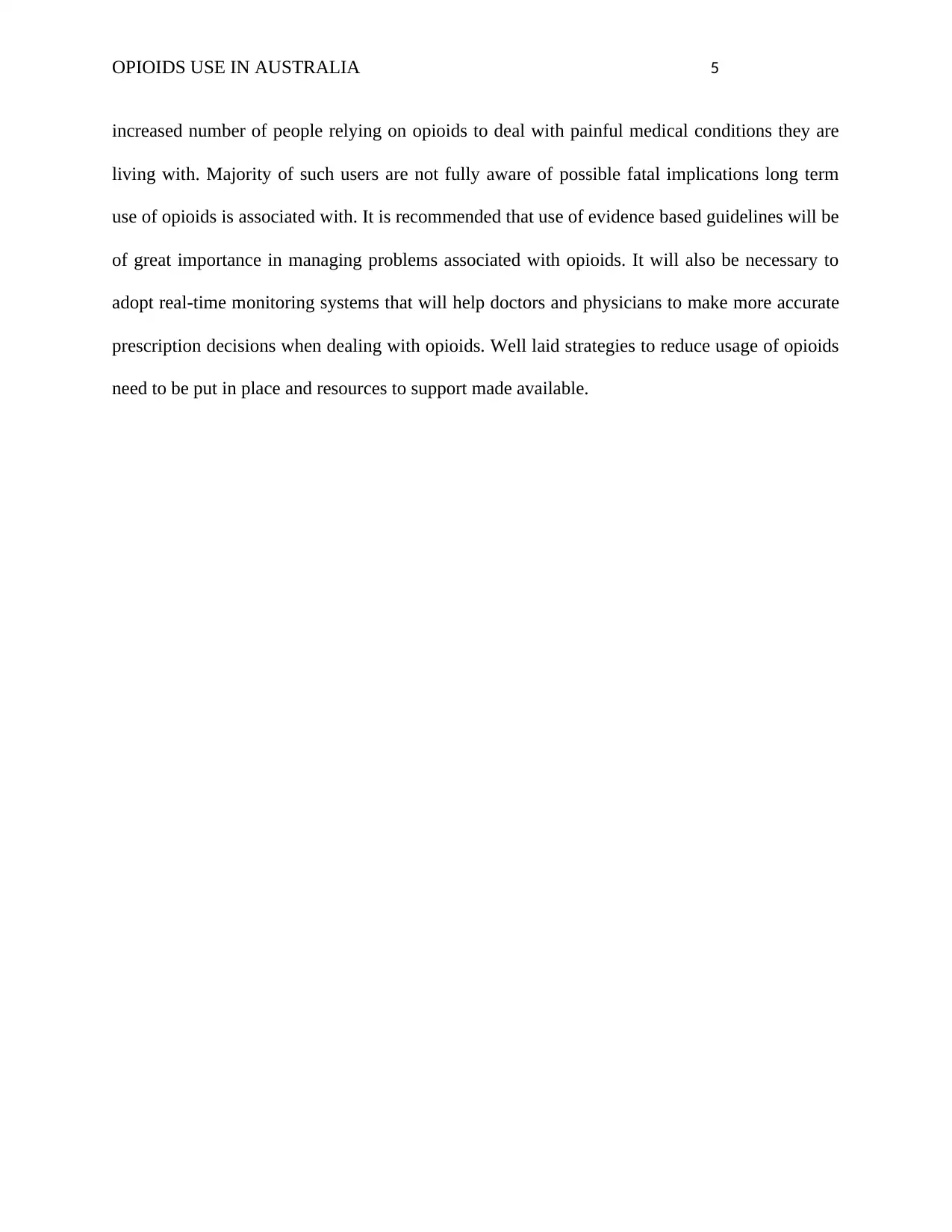
OPIOIDS USE IN AUSTRALIA 5
increased number of people relying on opioids to deal with painful medical conditions they are
living with. Majority of such users are not fully aware of possible fatal implications long term
use of opioids is associated with. It is recommended that use of evidence based guidelines will be
of great importance in managing problems associated with opioids. It will also be necessary to
adopt real-time monitoring systems that will help doctors and physicians to make more accurate
prescription decisions when dealing with opioids. Well laid strategies to reduce usage of opioids
need to be put in place and resources to support made available.
increased number of people relying on opioids to deal with painful medical conditions they are
living with. Majority of such users are not fully aware of possible fatal implications long term
use of opioids is associated with. It is recommended that use of evidence based guidelines will be
of great importance in managing problems associated with opioids. It will also be necessary to
adopt real-time monitoring systems that will help doctors and physicians to make more accurate
prescription decisions when dealing with opioids. Well laid strategies to reduce usage of opioids
need to be put in place and resources to support made available.
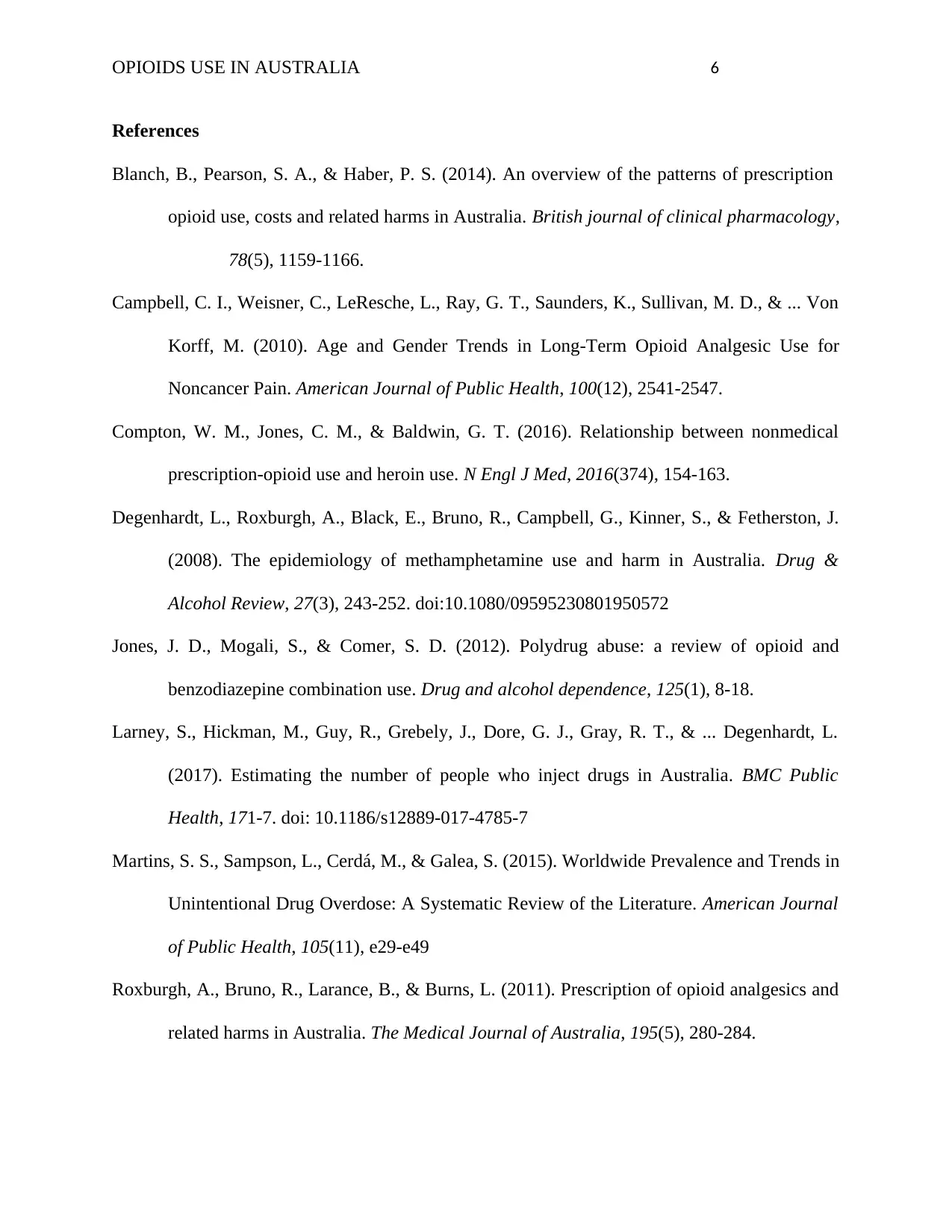
OPIOIDS USE IN AUSTRALIA 6
References
Blanch, B., Pearson, S. A., & Haber, P. S. (2014). An overview of the patterns of prescription
opioid use, costs and related harms in Australia. British journal of clinical pharmacology,
78(5), 1159-1166.
Campbell, C. I., Weisner, C., LeResche, L., Ray, G. T., Saunders, K., Sullivan, M. D., & ... Von
Korff, M. (2010). Age and Gender Trends in Long-Term Opioid Analgesic Use for
Noncancer Pain. American Journal of Public Health, 100(12), 2541-2547.
Compton, W. M., Jones, C. M., & Baldwin, G. T. (2016). Relationship between nonmedical
prescription-opioid use and heroin use. N Engl J Med, 2016(374), 154-163.
Degenhardt, L., Roxburgh, A., Black, E., Bruno, R., Campbell, G., Kinner, S., & Fetherston, J.
(2008). The epidemiology of methamphetamine use and harm in Australia. Drug &
Alcohol Review, 27(3), 243-252. doi:10.1080/09595230801950572
Jones, J. D., Mogali, S., & Comer, S. D. (2012). Polydrug abuse: a review of opioid and
benzodiazepine combination use. Drug and alcohol dependence, 125(1), 8-18.
Larney, S., Hickman, M., Guy, R., Grebely, J., Dore, G. J., Gray, R. T., & ... Degenhardt, L.
(2017). Estimating the number of people who inject drugs in Australia. BMC Public
Health, 171-7. doi: 10.1186/s12889-017-4785-7
Martins, S. S., Sampson, L., Cerdá, M., & Galea, S. (2015). Worldwide Prevalence and Trends in
Unintentional Drug Overdose: A Systematic Review of the Literature. American Journal
of Public Health, 105(11), e29-e49
Roxburgh, A., Bruno, R., Larance, B., & Burns, L. (2011). Prescription of opioid analgesics and
related harms in Australia. The Medical Journal of Australia, 195(5), 280-284.
References
Blanch, B., Pearson, S. A., & Haber, P. S. (2014). An overview of the patterns of prescription
opioid use, costs and related harms in Australia. British journal of clinical pharmacology,
78(5), 1159-1166.
Campbell, C. I., Weisner, C., LeResche, L., Ray, G. T., Saunders, K., Sullivan, M. D., & ... Von
Korff, M. (2010). Age and Gender Trends in Long-Term Opioid Analgesic Use for
Noncancer Pain. American Journal of Public Health, 100(12), 2541-2547.
Compton, W. M., Jones, C. M., & Baldwin, G. T. (2016). Relationship between nonmedical
prescription-opioid use and heroin use. N Engl J Med, 2016(374), 154-163.
Degenhardt, L., Roxburgh, A., Black, E., Bruno, R., Campbell, G., Kinner, S., & Fetherston, J.
(2008). The epidemiology of methamphetamine use and harm in Australia. Drug &
Alcohol Review, 27(3), 243-252. doi:10.1080/09595230801950572
Jones, J. D., Mogali, S., & Comer, S. D. (2012). Polydrug abuse: a review of opioid and
benzodiazepine combination use. Drug and alcohol dependence, 125(1), 8-18.
Larney, S., Hickman, M., Guy, R., Grebely, J., Dore, G. J., Gray, R. T., & ... Degenhardt, L.
(2017). Estimating the number of people who inject drugs in Australia. BMC Public
Health, 171-7. doi: 10.1186/s12889-017-4785-7
Martins, S. S., Sampson, L., Cerdá, M., & Galea, S. (2015). Worldwide Prevalence and Trends in
Unintentional Drug Overdose: A Systematic Review of the Literature. American Journal
of Public Health, 105(11), e29-e49
Roxburgh, A., Bruno, R., Larance, B., & Burns, L. (2011). Prescription of opioid analgesics and
related harms in Australia. The Medical Journal of Australia, 195(5), 280-284.
⊘ This is a preview!⊘
Do you want full access?
Subscribe today to unlock all pages.

Trusted by 1+ million students worldwide
1 out of 6
Related Documents
Your All-in-One AI-Powered Toolkit for Academic Success.
+13062052269
info@desklib.com
Available 24*7 on WhatsApp / Email
![[object Object]](/_next/static/media/star-bottom.7253800d.svg)
Unlock your academic potential
Copyright © 2020–2025 A2Z Services. All Rights Reserved. Developed and managed by ZUCOL.




